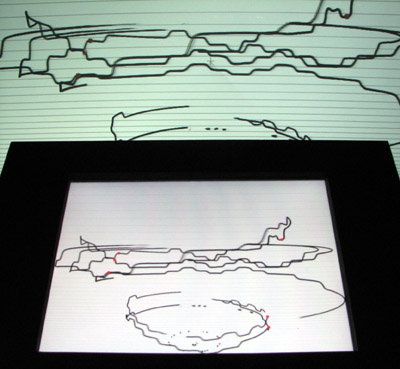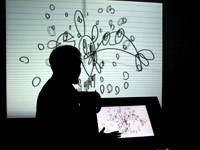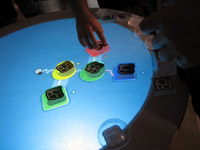 |
[September 13th 2005]

Amit Pitaru: Sonic Wire Sculptor. Photo: Thomas Petersen.
Artistic Interfaces. Between Instrument and Artwork
At three separate venues at Ars Electronica 2005 in Linz, Thomas Petersen found examples of hybrids between artworks and artistic instruments, which explore the relations between sound and vision in physical and virtual space. In this article he offers a few perspectives on what we can learn from these artistic interfaces.
Creative Interactivity Required
Certain types of digital artifacts place themselves firmly in the border zone between instruments for artistic production and artworks. They are 'artistic interfaces' in both senses of the concept. On one hand, they constitute useful interfaces for users to create independent artistic expressions. On the other hand, these tools are artworks in their own right, which offer critical perspectives on the concept of the instrument itself and the dynamics of the creative process.
In the field of digital culture the difference between instrument building and art-making can often be quite subtle. In some cases there are not necessarily any structural differences between an interactive artwork and an interactive space for users to produce aesthetic experiences because they can share characteristics as interactivity, interchangeability, transformation, user-controlled graphics and sound etc. Of course many digital pieces are a far cry from resembling tools e.g. genres like hypertext fiction, point-and-click game environments etc. The defining characteristic of the artistic interface is a specific type of interactivity where the common denominator is a large number of reconfigurable elements, the total sum of which create a manipulable space into which the user can project ideas and expressions. This space depends totally on direct creative interaction from the user.
Each of the following pieces are frameworks of possibilities and limitations. They do not promise more complex or superior results than conventional or analogue instruments, but constitute specific explorations of the production of aesthetic results within certain boundaries. These pieces are critical approaches to the technologies of creative production and can be considered as complex artistic statements in themselves.
 
Amit Pitaru: Sonic Wire Sculptor. Photos: Thomas Petersen.
Drawing Sculptures of Sound
An immensely popular work at the Cyberarts exhibition at Ars Electronica was Amit Pitaru's Sonic Wire Sculptor, which received an Honorary Mention in the Interactive Art category. This piece attracted quite a crowd in a stuffy room at the O.K Centrum für Gegenwartskunst.
Sonic Wire Sculptor deals with the production of sound by means of three dimensional wire drawings. It explores the correlation between vision and sound as the user literally draws the sound with a pen at a drawing station. The drawings are inserted in a rotating 3d-space as spinning wire sculptures. As this virtual space rotates 360 degrees, the sculpture is interpreted by the computer and transformed into sound according to the initial speeds and positions of the drawings. The vertical axis determines the pitch, notes are indicated by horizontal lines and a metronome can be found at the centre of the stage. The user can save and retrieve the sculptures, stop the rotation and reposition the compositions freely to reconfigure the elements within a new tonal space. The installation of the piece in the exhibition space is based on surround sound so the sound in the physical space reflects the structure of the virtual sculpture.
Compared to many other similar projects the piece distinguishes itself by actually being playable as a performance instrument. It can be used as a precise musical instrument by means of the guidelines to achieve specific notes and precise rhythm. A practical implementation into a joint performance setting is definitely conceivable. The piece is a critical approach to the production and representation of sound at the same time. The wire sculptures are an original counterpart to the conventional note system and a dynamic equivalent to graphic notation systems like the ones used by composers like John Cage, Brian Eno etc.

Golan Levin: Scrapple: A physical active score table. Photo: Thomas Petersen.
A Playful Physical Sequencer
A similar project is Golan Levin's Scrapple: A physical active score table, which was presented at the Ars Electronica Center across the Nibelungen bridge. As with Pitaru's Sonic Wire Sculptor, Levin's piece Scrapple deals with the transformation of shapes into sounds. In this case the piece is based on the configuration of physical objects on a table, transforming them into a musical score.
Instead of placing samples in a sequencer or notes on paper, Scrapple adds a physical dimension to computer-generated music. The user has to move and adjust objects to indicate rhythm, tones, melody etc. The visual result quickly ends up as an abstract composition of shapes corresponding to sound. The strength of the piece is not so much being a precise musical instrument but rather a very enjoyable toy appealing to the playful interaction between several users at a time. It also adds a bodily aspect forcing the users to move swiftly around the table.
Other projects by Golan Levin touch upon similar aspects. In The Manual Input Sessions, hand gestures, finger movements and other objects are analyzed by custom software generating graphics and sounds. In Yellowtail, virtual worm-like creatures are drawn by the user on a screen and transformed into sound by a scanning mechanism.
   
The reacTable* developed at the Music Technology Group, Pompeu Fabra University, Barcelona. Photos: Thomas Petersen.
Augmented Table Composition
Going back over the bridge to the 'Interface Culture' exhibition at Kunstuniveristät Linz (Art University of Linz) The reacTable* was exhibited next to a number of experimental interfaces. This particular piece was developed at the Music Technology Group, Pompeu Fabra University, Barcelona.
The instrument consists of a round table and plastic objects marked with various symbols. Based on these symbols a camera tracks the position and direction of the objects when they are placed on the table. When one of the objects is placed, the particular symbol is recognized and the immediate environment is augmented with graphics indicating the functions of the element. Some of the objects produce sound and other objects modify these sounds. Some events can also affect the general visual appearance of the table. The total sum of events creates a dynamic, tangible interface with virtually unlimited possibilities in the creation and visualization of sound. The visual result is a stunning abstract animation generating buzzing, clicking and humming compositions.
The interface allows the composer to handle physical objects to generate digital sound supported by a full range of dynamic visualizations. As opposed to the widespread use of e.g. the laptop as a performance instrument, the strength of reacTable* is its tangibility and involvement of the user's body to manipulate digital sound. reacTable* has a social and telematic dimension as there is the possibility of involving distant participants at a shared table. The piece was used in a collaborative performance between Linz and the ICMC conference in Barcelona Spain. The two tables shared musical components and the composers could affect each other' s components in a shared performance situation.
Basic Research
The range of strategies shows us that the visualization/notation of sound is not an unequivocal project. The correlation between sound and vision is a magnet for pioneering instrument builders, simply because this space can never be definitively charted. Each instrument constitutes an interpretation of the ephemeral nature of sound and a longing to map it. The result is an abundance of complex analyses of aesthetic transformations and some very interesting artistic interfaces.
The sheer amount of different strategies of this kind points to the fact that the artistic instrument is under full-scale development these days. These experimental instruments can be regarded as basic research into alternative ways of creating and visualizing music. Because they take place as an experimental practice between art-making and instrument building they can establish interactive spaces which may not have the potential to survive on a commercial market. Certain aspects of these instruments will most likely find their way into commercial production and some of them will maybe become commonplace performance tools - some will not. Whatever their future destinies may be, they are nonetheless important as singular statements and they demonstrate the importance of experimental spaces to develop and test new approaches to artistic tools.
Related links
- Online version of Amit Pitaru's Sonic Wire Sculptor: http://www.pitaru.com/sonicWireSculptor/
- Amit Pitaru's website: http://www.pitaru.com
- Golan Levin's website: http://www.flong.com
- Yellowtail by Golan Levin: http://www.flong.com/yellowtail/index.html
- The Manual Input Sessions by Golan Levin: http://tmema.org/mis/
- reacTable*: http://mtg.upf.edu/reactable/
- A list of tangible musical interfaces: http://www.iua.upf.es/mtg/reacTable/MusicTables/
- Ars Electronica website: http://www.aec.at
|
 |
|